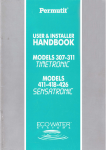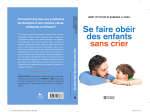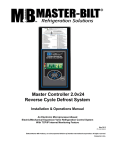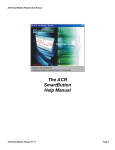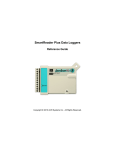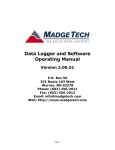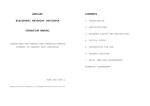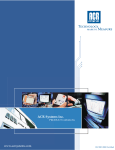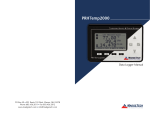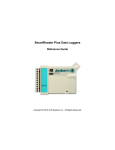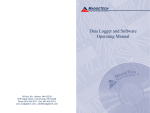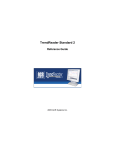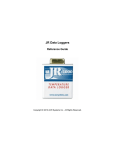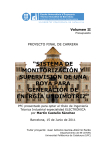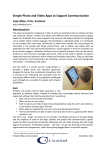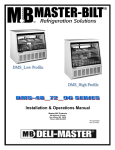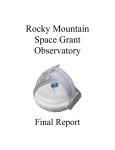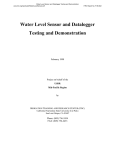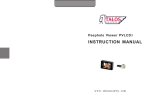Download Zach Andrews Eric Barr Brandon White November 2, 2009 Luke
Transcript
Zach Andrews Eric Barr Brandon White November 2, 2009 Luke Reese Biosystems and Agricultural Engineering MSU Dear Dr. Reese: Attached is our rough draft for Dr. Dan Guyer’s project. This project includes researching, designing, and implementing a working, remote refrigeration monitoring unit, for protecting valuable research items stored within refrigeration units. Housed in the annex behind Farrall Hall, three Master-Bilt walk-in refrigeration units will be monitored. Thank you for this opportunity. We look forward to completing this project on December 16, 2009 Sincerely, Zach Andrews Eric Barr Brandon White Enclosure Problem Statement Three Master-Bilt V39LX094XX commercial walk-in refrigeration units exist in the annex behind Farrall Hall on MSU’s campus. They are used to store research material for MSU faculty, graduate, and undergraduate studies within the College of Agriculture and Natural Resources. Currently there is no way to remotely monitor if any malfunction occurs on any of the units, whether it is compressor failure, power outage, or even if the internal environmental conditions are unsuitable. This may result in valuable research material being lost. A monitoring system needs to be implemented to alert the client of a malfunction and constantly record internal environmental data. Project / Client Description The Refrigeration Monitoring System (RMS) is needed to monitor primarily for compressor failure, as well as power outages and irregular temperature fluctuations. The consequence of compressor failure is a rapid temperature rise inside the cooler, and ultimately the spoilage of all contents. Materials in the cooler are designated for research and spoilage can cost the University a significant loss of data and ruin research projects. Upon compressor failure, the evaporator fans blow only warm air created by the fan motors, thus warming up the cooler even faster. During the case of a power outage all components of the refrigeration unit cease to operate, rendering them as icebox units, slowly raising the internal temperature. If the internal temperature of the refrigeration units could be monitored remotely at regular intervals, damaging temperatures might be averted by alerting someone of the system failure. Our proposed monitoring system design would implement a linkage between sensors, data loggers, and the client’s computer or cellular phone. Through this system, the client will be Page | 1 able to monitor temperature and relative humidity remotely, this will allow them to receive alerts if a refrigeration unit malfunctions, a power failure occurs, if humidity levels become unsuitable for research materials, or if any other event leads to a significant change in temperature. Upon alert notification, the client can acknowledge and repair the malfunction before the internal conditions of the unit become unsuitable and its contents are damaged. If time allows, the group also would like to consider mechanical/electrical backup system that would increase the amount of time between the alert and the onset of damaging internal environmental conditions. This system would simply shut off the evaporators during the event of compressor failure turning the refrigeration units into effective insulated ice boxes. This would allow more time for the client to respond to the alert and assess the malfunction before content damage occurred. If time does not allow for the implementation of such backup system, because it could be installed without affecting the implied monitoring system, this could be set up as a secondary project to be designed and installed at a later date. Client Our client is Dr. Daniel E. Guyer, Professor of Biosystems and Agricultural Engineering at Michigan State University. His Extension and Research includes postharvest handling, valueadded processes for fruit, vegetables and chestnuts, as well as spectral analysis, machine vision and pattern recognition for agricultural sensing applications. Dr. Guyer’s profile is found at (http://www.egr.msu.edu/age/guyer.html) Assisting Dr. Guyer on this project is Steve Marquie, research assistant for Biosystems and Agricultural Engineering. Mr. Marquie has expertise in instrumental equipment technology and will be guiding and helping with any tech problems. Steve Marquie’s profile is found at (http://www.egr.msu.edu/age/marquie.html) Page | 2 Situational Analysis Audience For the target audience, we have some stipulations that must be considered. In general, the personnel using the system may not have an extensive background in the equipment setup. It is very important that the system be very user-friendly to aid in its upkeep and utilization. The following demographics are to be considered about our user audience: • Typical occupations: MSU professors and students • Typical age: 20+ • Gender mix: about equal • Education level: college • Audience’s knowledge level of the subject: low • Audience’s interest level: high • Estimated audience size: 25-50 people The most significant bullet point in the above list to us is the low knowledge level. To combat this problem our plan is to assemble a user’s manual that will allow the audience to easily analyze and understand the system. The manual will include information from the individual component manuals, a complete system description, and troubleshooting methods. Environment This monitoring unit will be housed in the annex behind Farrall Hall on Michigan State University’s campus. This facility is equipped with heat, 120 volts AC power, Internet via Ethernet cable, and telephone connection. All system components will be contained and operating within the annex. The refrigeration units are located against the west wall of the Page | 3 building. This positioning renders the back of the units unavailable however the top is easily accessible for running wires and conduit into the coolers. The Ethernet cable that supplies the internet source will allow for remote accessibility of the monitoring system. Expectations The most important expectation placed upon our group is that the whole system be fully operable as soon as possible, but also be reliable and easy to use. We are required to research the most cost effective and easy to operate solution that we can find in a timely manner. It is desired that we have the aforementioned user manual completed soon after installation. Further we are expected to handle both the design and installation aspects of the project. Objectives • Design system that monitors temperature and relative humidity inside all three MasterBilt V39LX094XX refrigeration units • System should allow for real-time monitor, display, and alert when system fails • System design requirements o Temperature accuracy: Minimum +/- 0.5°F o Temperature resolution: Minimum +/- 1°F o Humidity accuracy: Minimum +/- 0.5% o Humidity resolution: Minimum +/- 1% o System must be able to log measurement data o Must be able to record data in time intervals as small as 1 minute apart • Research best-priced and most highly functional alternatives for monitoring units • Formulate block diagram to compare all alternatives prior to selection Page | 4 • Research refrigeration units requirements (i.e. drilling procedures, warranty information, design specs, dimensions) o CAD draw up of units • Research all costs o Sensors and logging equipment o Wiring and conduit o Create order form • Install proposed system according to design • Assemble user manual to aid in troubleshooting and understanding of system • Meet all assignment deadlines within the project • Complete final report by December 16, 2009 • If time allows, research, design and install backup that shuts down unit completely o Prevents overheating and allows time for client to identify problem Schedule • Every Thursday, 9:00am – 10:00am: Meeting With Dan Guyer and Steve Marquie • Every Wednesday, 6:00pm – 10:00pm: Group Meeting • September, 24: Initial project meeting with Dan Guyer and Steve Marquie • October, 8: Complete Project Management Contract • October, 15 Project rough draft/outline completed • November, 3 Secondary project rough draft completed • December, 10 Project poster completed • December, 11 Oral Presentation, Project 90% - 95% completed Page | 5 • December, 16 • (MS Project Gantt Chart) Project 100% Complete, Final written project report completed Scope The scope of this project is to provide an answer for a large weakness in the security of this particular refrigeration system. Our client has stated to us his constant concern for the condition of the units after he leaves the area for the day. Without our system in place, these units would require constant human supervision, which is simply not an option. Otherwise items/research that depends on these refrigeration units are in constant jeopardy of a unit failure that may not be discovered until valuable research material has been damaged. Our aim is to not only alert the proper individuals immediately if such a failure should occur, but to record unit conditions over time and allow web/phone access to these records. Assumptions Our main assumptions are focused on the installation of our proposed system. During the installation, we will need to mount our probes inside of all three refrigeration units and connect them to the CPU of the system mounted outside of the refrigeration units. The first assumption deals with the wiring between the two. All sensors are connected by CAT5 wiring, so we should be able to bypass drilling into the refrigeration units by following the same path with our wires as the standard wiring already running into the unit. This would save us precious time and unnecessary actions in our installation. If for some reason, we encounter a problem that prevents us from using this method, the new conduit will have to be run and a new hole will have to be drilled for that conduit. Page | 6 Another installation assumption deals with their mounting procedure. It is assumed that a very strong adhesive may qualify to mount the probes into the refrigeration unit which also would help to minimize drilling and possible errors. If for any reason at all, the probes are suited for mounting into the ceiling of the unit, it would require a slightly larger hole to be drilled into the ceiling so that the probe may protrude out of it. Another option would be to use a custom wall-mount bracket with self-tapping screws to mount the unit to the wall securely. Research and Research Methods Refrigeration Units The units used are a custom commercial walk-in refrigerator/freezer set up by Master-Bilt Refrigeration Solutions. Model V39LX094XX. The custom three unit design is housed in a single structure with external dimensions measuring 277”L x 93”W x 98.25”H. For more detailed dimensions, diagrams, and pictures refer to Appendix A and B. For our research we used Google as our primary search engine. Due to the fact that we were researching products to buy we didn’t necessarily need advanced search engines or journal databases. The search engine was used to find different RMS design options and prices and also to find details on the refrigeration units that we are working with. To research the cost of construction materials we used www.lowes.com to establish a baseline estimate price. We also used our client Steve Marquie’s suggestions for keywords in our search. Some of the keywords that we used were: • Data loggers • Temperature and RH probes • Logging software • Campbell Scientific • Omega • National Instruments Page | 7 • Record temp and RH • Master-Bilt refrigeration • Data Acquisition • UPS battery backup Along with our internet research we utilized the knowledge of the MSU staff to aid in our design. Steve gave us valuable information and feedback, and we spoke with Phil Hill about the actual installation process. He gave his opinion on logger and probe mounting techniques and also let us know what materials in the annex we could use for the construction. We were also granted access to necessary tools in the shop that he oversees. When we get ready to run wire and conduit we may also consult Truman Surbrook or Jon Althouse for electrical codebook parameters. Options Option 1: Sensatronic's Environmental Sensing (http://www.microdaq.com/sensatronics/senturion/rackmount_environmental_monitor.php) One option for hardware is the Sensatronic Senturion Rack-Mount Environmental Monitor, as shown in Figure 1. This unit is virtually an all-in-one unit to complete the tasks that we require. The unit can monitor/log the desired conditions of all 3 refrigeration units, allow users to access this info from anywhere using the Internet via its static IP address, and send alerts by emails/phone numbers during alarm situations. The main argument for this unit is that it is extremely customizable and extremely user friendly. All features are self-contained within this unit, eliminating the need to piece together a working system from many different products. It is additionally capable of running many different sensors and probes at the same time, such as temperature and relative humidity probes, sensors that record whether the doors are open or Page | 8 closed, and power presence probes. Suggested features include a power presence probe as well as an Uninterrupted Power Supply (UPS) that will continue to power the unit for a limited time during a power-loss, allowing for alerts to be sent to the client. Sensors: Sensatronic’s Temperature and Relative Humidity Probe • • • • Air Temp Accuracy: ±5oC Air Temp Measurement range: -40o to +85o RH Accuracy: ±2%RH RH Measurement Range: 10% to 90% Figure 1. Sensatronic’s Temp &RH Probe Data Logger: Sensatronic’s Senturion Rack- Mount Environmental Monitor • User friendly • Rugged • Multiple inputs • Remote Alarms • LCD Readout • Web Based operation Figure 2. Sensatronic’s Senturion Rack‐ Mount Environmental Monitor Item Price Quantity Total Sensatronic Senturion Rack-Mount Environmental Monitor $949.00 1 $949.00 External Temp/RH Probe w/ 50ft. cable $185.90 3 $557.70 Power Presence Probe w/ 50ft. cable $139.70 1 $139.70 $0 1 $58.99 $218.90 1 $218.90 $68.20 0 $0.00 UPS Battery Backup (Available through Client) Automated Phone Dialer Magnetic Door Sensor w/50ft. cable Total $1865.30 Chart 1. Itemizes the components and cost for this option Page | 9 Option 2: Using Campbell Scientific components (http://www.campbellsci.com/) pThe second option would utilize three HMP45C Temperature and Relative Humidity probes from Campbell Scientific, one inside each of the refrigeration units to take readings. The probes will require a to the data logger, preferably CR1000. The data logger would then be connected to a computer running RTMCPRO Real-Time Monitor & Control Software. While being connected to the Internet, these components will allow us to remotely monitor and alert on temperature and humidity readings. Sensor: Campbell Scientific HMP45C (Temp and RH Probe) • Rugged • Air Temp Accuracy: ±.5oC • Air Temp Measurement range: -39.2o to +60oC • RH Accuracy: at 20 oC ±1%RH • RH Measurement Range: 0.8 to 100% Figure 3. HMP45C Temp and RH Probe Data Logger: Campbell Scientific CR1000 • Rugged • Multiple inputs • Remote alarms • Available through client RTMCPRO software: • Remote monitoring via internet server • Email alerts Item HMP45C Temp and RH Probes CR1000 Data Logger (Available through Client) RTMCPRO Software PC (Available through client) Figure 4. CR1000 Price Quantity Total $600 3 $1800 $0 1 $0 $435 1 $435 $0 1 $0 Total $2235 Chart 2. Itemizes the components and cost for this option Page | 10 Option 3: Omega Engineering, Inc. (http://www.omega.com) When evaluating the potential options available through Omega Engineering, Inc., it appears quite evident that they offer the most cost friendly alternative of the considered manufacturers. The temperature and relative humidity sensors come packaged inside of the data loggers which cuts out one more part of the system under this option. The logger/sensor is then linked to a computer, which must have the mandatory software to display the recorded values. The linkage to the computer is established through the COM port on the back of the CPU. The logger/ sensor unit can be purchased for $199.00 while the software is sold for $99.00. This gives a total cost of $696.00 plus shipping for the required equipment from OE Inc. Logger/Sensor: Omega OM-CP-RHTEMP101 • • • • • • Air Temp Accuracy: ±.5oC Air Temp Resolution: .1oC Air Temp Measurement range: -40 to +80oC RH Accuracy: at 25 oC ±2%RH RH Resolusion: 0.5% RH RH Measurement Range: 0 to 100% RH Figure 5. OM‐CP‐RHTEMP101 Software: • • • Sends alarms through e-mails or numerically coded phone call Syncs data from several logging inputs together Icon in software allows easy exportation to Microsoft Excel spreadsheet Item OM-CP-RHTEMP101 OM-CP-IFC110 PC (Available through client) Price Quantity $199.00 3 $99.00 1 $0 1 Total Total $597.00 $99.00 $0 $696.00 Chart 3. Itemizes the components and cost for this optio Page | 11 Although these options are very cost effective and seem relatively user friendly, we did not choose to implement any of this equipment into our system. One of the major concerns was with the use of a software program to record the data. This of course means that a computer must be located near the refrigeration units in order to accept the information from the logger/sensor. This was an issue for us because while there is a computer available, it is an older model and there could be issues with computer failure. The software is the only part of this system that sends any kind of alarm so if the software is not able to run the whole system would be useless. Another issue was the price of the equipment. While saving money and staying under the budget is a significant positive, we felt that there was a point that things can become cheap and we didn’t necessarily want that. We reasoned that spending a little more money would save breakdowns and headaches, based upon the theory that one gets exactly what one pays for. Option 4: ACR Systems, Inc. (http://www.acrsystems.com) The Fourth option that we discussed was provided by ACR Systems, Inc. The desired equipment included a data acquisition logger, two temperature and RH probes, and the compatible software. The logger contains four channels with two allocated to temperature and RH directly measured from the logger’s location. The other two channels can be used for temperature and RH probes that can be routed from the first refrigeration unit to the others. This requires that all equipment be contained inside of the units with the USB interface cable running from the logger to the computer. The computer must be equipped with the Trendreader software in order to take in data. From there the information can be exported to an Excel file. Page | 12 Logger/Sensor: ACR Smartreader 2 • • • • • • Air Temp Accuracy: ±.2oC Air Temp Resolution: 1 oC Air Temp Measurement range: -40 to +70oC RH Accuracy: ±4%RH RH Resolution: 0.4% RH RH Measurement Range: 0 to 95% RH Figure 6. ACR Smartreader 2 Software: Trendreader 2 • • USB interface Capable of exporting to Excel Item ACR Smartreader 2 logger Remote Temp/RH probes Trendreader 2 software PC (Available through client) Price Quantity $860.00 1 $239.00 2 $240.00 1 $0 1 Total Total $860.00 $478.00 $240.00 $0 $1578.00 Chart 4. Itemizes the components and cost for this option Upon considering the other options and what was required of the system, we were forced to eliminate ACR due to the fact that it cannot send alerts of any kind. It only records data and displays it. Alerts are the key inclusion into our system design and the lack of its availability in this software renders it useless to us. Evaluation After carefully considering all of our possible hardware/software options, we have decided that the best choice is clearly the Sensatronics Senturion Temperature Monitor. This is a small unit, measuring 19.00in x 3.94in x 1.77in, which can easily be wall mounted for this application. When rating each unit in its ability to satisfy the needs required, this model not only Page | 13 excelled in each category, but added a sense of simplicity to each action that no other unit came Cambell Scientific Sensatronics Senturion Omega Instruments ARC 59 34 22 Total Cost Email Alarms Phone Alarms Visual/Audible Alarms Power Presence Alarm Remote Web Access Computer Interface Battery Backup Expandability Warranty Delivery User Friendly 37 close to matching. Below is a decision matrix we constructed to aid in our evaluation. 4 5 3 0 0 4 4 5 4 4 1 3 4 5 5 5 5 5 5 5 5 5 5 5 5 5 4 0 0 0 3 5 2 2 5 3 4 0 0 0 0 0 3 5 2 3 2 3 Chart 5. Component option decision matrix (Scoring (1‐5) 5=Best 1=Worst) The first basic requirement is the ability to accurately monitor/log the temperature and relative humidity conditions within multiple areas. This unit easily passes this test with external 2-in-1 probes that monitor both. The temperature range of these probes, which extends from 40°F to 185°F, goes well beyond our requirements. These probes also have an accuracy of +/0.9°F within the temperatures they will be utilized at, and an accuracy of +/-2.7°F at more extreme hot/cold temperatures, which are beyond adequate. Relative humidity can be tracked between 10-90% with an accuracy of +/-2%. All logging intervals are also completely Page | 14 configurable. These probes are also manufactured by Sensatronics and made specifically for this unit, so integration is made as simple as possible. These probes connect to the unit via RJ12 connections and have a plug-and-play setup. This unit also manages to log data via easy to use software already included/installed into the unit itself. The unit allows the user to label each probe and easily view conditions via a builtin LCD display located on its front panel. Users use this screen along with the buttons located on the unit to configure every aspect of its settings such as acceptable ranges, labels, alerts, administrators, data graphing, etc. This unit has a built-in web interface so you have a complete, stand alone unit that doesn’t require an external PC to operate. All the other options require a PC to function. The monitor requires an Ethernet connection and can utilize either a standard or dynamic IP address. This monitor retains up to 122 days of data. To store info beyond that range, it can upload data to a designated server folder in the form of a .csv file, which can easily be displayed in Microsoft Excel. This web-interface will allow the user to remotely access all conditions/data via the internet from anywhere. According to Sensatronics, any firmware updates that are released are completely free and update across the web automatically! The next major requirement that is a necessity of our chosen system is its alerting abilities. Once again, this unit easily ousted its competitors with its many strengths. This unit has the ability to set individual high and low threshold limits for each probe in use. Other systems were also able to do this, but the Sensatronics system surpassed these units in its numerous response options. The unit has a wide range of actions that can be configured to respond to unacceptable conditions. This list includes flashing its LCD screen bright red, audible alerts, and e-mail or text alerts to multiple administrators. This convenience is then multiplied by its ability to set up multiple reactions during different unacceptable condition scan counts. This allows the Page | 15 unit to execute different actions over the course of continuing alarming conditions. This could allow the system to begin with a relatively light course of alarm action, and then gradually escalate its actions until the alarm is acknowledged. For example, let’s say the unit is set to scan conditions every minute. The unit can be configured to flash its lights and/or make an audible alarm during the first scan beyond its preset limits. This will allow anyone in the immediate area that may be currently using the refrigeration units and causing the conditions to respond to the alarm directly on the unit itself as soon as they are detected. This would prevent the unit from sending out unnecessary alerts to users when the problem can easily be taken care of by a local user. The unit could also be set to send a text/email to a particular administrator after six consecutive scans at unacceptable conditions. This will program the unit to allow 5 minutes for a local user to respond to these conditions before it decides to alert an administrator that is away. The great thing about the administrator set-up is that alerts to these users can be set independently. This means that it can be set to alert only 1 person (such as the person overseeing the particular research in the refrigeration units at the time) initially during unacceptable conditions, and then alert another person at a later time if the 1st person does not respond. Eight total responses can be programmed and they can be configured any way the user desires. This unit only needs one addition of external hardware which is a UPS to supply the 120VAC that it requires. The unit will shut down when power is lost, so this will allow the unit to continue to operate for a moderate period of time after any power outages to the UPS. We will couple this with an available power sensing probe that will monitor power between the wall outlet and the UPS and connect directly to the Sensatronics monitor. This will allow the unit to know when power has been lost and alert the administrators while it is still operational, made possible though the addition of the automated phone dialer, assuming that the phone lines are not Page | 16 down as well. This category still has the Sensatronics unit ranked at #1. Some other units are powered by batteries, but this would add additional effort to maintain the batteries. Other units require an add-on AC power supply conversion. Even if any of the other units seemed better suited in the power supply category, the Sensatronic’s aforementioned ability to operate without an external PC allows it to prevail in the external necessities category. Last, pricing was taken into consideration. The Sensatronics unit was not the most inexpensive of our possible options; however, it easily fit into our $3000 budget. The unit was not the most expensive option and was not very far off from its less expensive competitors. After rating all units in all of the previously mentioned areas, it is pretty clear that the Sensatronics has an extremely high value per dollar. In this sense, the Sensatronics, once again, scores better than any of its competitors. Budget The project was given a $3000 budget at the first meeting. The client informed us that this money was not directly supplied by the university. Our goal is to complete this project while remaining under budget. After completing our evaluation and deciding on the Option 1 using the Sensatronics equipment, we constructed a customized order form (Appendix C), to use for purchasing the equipment. The order form contains three different pricing packages. Package one contained just the essential equipment we needed to get the system up and running, ($2,024.29). Package two contained extra power presence probes to monitor the compressors individually, ($2,443.39). Package three contains extra sensors to monitor unit door activity, ($2,228.89) Page | 17 Item ¾” PVC conduit ¾” PVC T connector ¾” PVC LB connector Silicone tube 1 ½” wood screws (logger mounting) 1” self tapping metal screw Quantity 42’ 2 3 1 1 box of 25 1 box of 50 Price $0.94/10’ $2.97 $2.98 $5.97 $4.97 $4.92 Total Total $3.95 $5.94 $8.94 $5.97 $4.97 $4.92 $34.69 Chart 6. Installation Supply List Necessary tools: • • • • • • Drill Hole saw drill bit Hex head drill bit for screws Silicone gun Saw for cutting PVC PVC glue and cleaner http://www.lowes.com Design Although we have not received any parts/equipment to begin installation yet, it was imperative that we research the entire process from start to finish, To determine the best option. We began from the core of the system and determined the best place to mount the actual unit and how. We determined a suitable spot directly next to the refrigeration units located on the wall of the annex near where the units are located in. This area is located safely away from the dangers of foot/equipment traffic through the annex. It is also very close to a suitable area to connect the power supply. To mount the unit, we will first mount a plywood base to the annex wall, and then mount the unit and UPS to this base. There is also a suitable Ethernet connection already established in the immediate area to connect to. Page | 18 We then considered the next part of the system, which is the wiring connecting the main unit to everything else. We realized that all wiring would need protection from many hazards such as other equipment and wildlife. We specified suitable forms of conduit for this application and have been informed that our clients may already have it. We measured every length dimension of the refrigeration units, inside and outside, and created a replica of the units using AutoCAD software. This allowed us to easily determine needed measurements such as required wire length and the best paths of installation. We determined the proper tools and drilling procedure to create the paths needed for wiring/conduit from the exterior of the refrigeration units to its interior. A form of silicone caulk will be used to seal off around the conduit once it is run through the wall. The last systems installations are the probes that will be mounted inside the refrigeration units. This should be a simple procedure. We’ve decided on constructing shields that will double as the mounts for the sensors out of pvc. We will take temperature readings in many different areas of each of the three refrigeration units. This allowed us to determine how much the temperature varied in different areas, and choose a mounting location that would yield the average temperature across the unit. We also made sure to choose an area that is located out of harm’s way from research and equipment that is moved in or out of the units. (More Details on design Installation to come.) Page | 19 Appendix A Top View Side View Front View Page | 20 Appendix B More pictures to come. Page | 21 Appendix C Page | 22
























